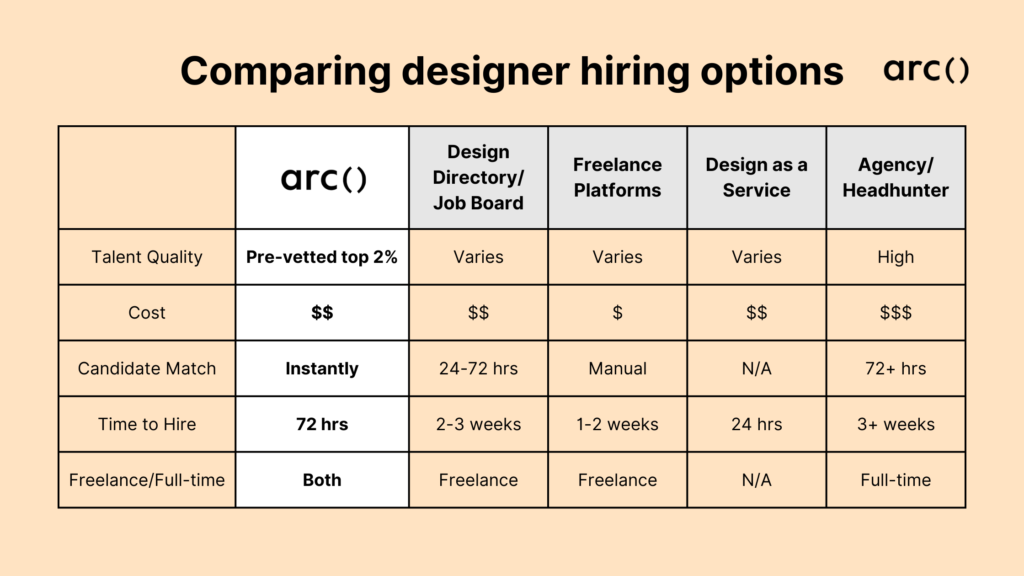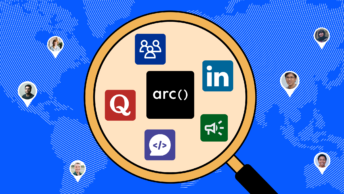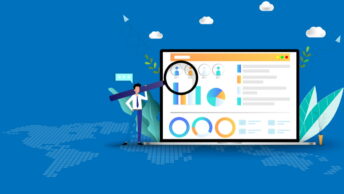As an early-stage startup founder, you know that great design can make or break your product. This includes both product and visual designers. But finding and hiring the right person can be a daunting task. This comprehensive guide will walk you through everything you need to know about hiring designers, from understanding the role to managing the hiring process.
The Role of a Designer in Early-Stage Startups
Before diving into the hiring process, it’s crucial to understand what you’re looking for in a designer. For early-stage startups, the ideal founding designer often needs to wear multiple hats.
Designer Skills
- UX (User Experience): This involves designing the overall experience of your product, focusing on user flow, information architecture, and usability.
- UI (Visual Design): This covers the visual aspects of your product, including layout, color schemes, and overall aesthetics.
- Specialized Roles: Depending on your needs, you might also look for skills in:
- Visual Communications
- Graphic Design
- Brand Design
- Marketing Design
What Early-Stage Startups Need
As an early-stage startup, your design needs are likely to be broad and varied. Here’s what to keep in mind:
- Look for a generalist: Seek designers with broad experience across various design disciplines. They should be comfortable jumping between different types of design work.
- Prioritize based on your product: If you’re building a mobile app, prioritize mobile UI/UX skills. For a B2B SaaS product, focus on designers with experience in creating intuitive dashboards and data visualizations.
- Ability to unblock engineers: Your designer should be able to provide clear, implementable designs that don’t slow down your development process.
Design Hiring Options
You have options when bringing design talent into your startup. Let’s explore each one:
1. Freelance Designer
- Ideal for:
Short-term or specific projects, or when you’re not ready for a full-time hire. You can hire freelance designers for small projects or overflow work, but consider contract-to-hire if you may want to convert to full-time later on. - Pros:
Quick turnaround, flexibility, cost-effective, and access to specialized skills. - Cons:
Less integrated with your team, potential inconsistency in design if you switch contractors often.
2. Full-Time Designer
- Best when:
You’ve reached Product-Market Fit (PMF) and have consistent design needs. They can help when you’re ready for a creative director, brand identity, or more long-term design work. - Responsibilities:
Leads engineers, drives product development, conducts user research. - Pros:
Deep understanding of your product and brand, consistent design language. - Cons:
Costly, may not be feasible for very early-stage startups.
3. Agency or Studio
- Not recommended for most early-stage startups due to high costs.
- Ideal for:
Long-term engagements or very specific needs that require a team of specialists. - Pros:
Access to a range of skills and resources. - Cons: Expensive, may be overkill for early-stage needs.
For most early-stage startups, we recommend starting with a freelance contract designer. This option provides the flexibility and expertise you need without the long-term commitment of a full-time hire.
Ready to hire the best freelance designers? Sign up now and Arc will find the perfect match for your project!
Where to Find Freelance Designers
When hiring freelance designers, accessing the right platforms is crucial to find the best talent. With many options available — from specialized design directories and freelance platforms to design-as-a-service subscriptions and professional headhunters — navigating these choices can greatly impact the success of your design projects.
Here’s a quick overview of different options:

Let’s start by exploring Arc, a platform often for hiring top global freelance designers at a fraction of the cost of US equivalents. Here’s why Arc might be the ideal match for your next design project:
Arc
When hiring freelance designers, Arc stands out as the best choice. Here’s why:
Vetted talent: Our freelance designers are rigorously vetted, ensuring you get only the best. Arc’s talent pool consists of the top 2% of designers, so you can trust that you’re hiring design experts who can deliver exceptional work.
Speed: Arc’s HireAI provides a shortlist of top designers in mere seconds. Just upload your job description, and you’ll instantly be introduced to three top designers. This means no more long waits or endless scrolling through portfolios.
Wide coverage: Meet vetted experts from around the globe spanning visual design, graphic design, game design, UI/UX, WordPress or Shopify design, and web design. Whatever your design needs, Arc finds the right expert for you.
Cost-effective: Freelancers on Arc set their own rates, typically between $30 and $100+ per hour, depending on their role, skill, and location. You only pay for the hours worked — no extra fees. For full-time remote hires, we charge a one-time fee based on the annual salary, making it a cost-effective solution for your design needs.
Global reach: With Arc, geographic limitations are a thing of the past. Tap into a global talent pool and find designers whose skills perfectly match your project’s requirements, no matter where they are located.
Flexible hiring options: Whether you need freelance contractors for short-term projects or full-time remote team members for ongoing work, Arc has you covered. Our platform is designed to accommodate your specific needs, allowing you to scale your design resources as required.
How Arc Works
- Share your requirements- Tell us about the role and project, the skills required, your hiring budget, and the desired location of your freelance designers.
- Start interviewing – We’ll connect you with pre-screened remote designers who perfectly match your requirements and are ready to be interviewed.
- Make a hire- When ready, hire a remote freelance designer, sign an NDA, and we’ll take care of the rest.
Rest assured there’s a no-risk trial period if you’re not satisfied for any reason, we will help you find a replacement!
Ready to hire the best freelance designers? Sign up now and get the perfect match for your project!
Other Options for Hiring a Freelance Designer
Use a design directory
Design directories screen designers for skills and expertise, ensuring you get quality matches and you pay per hour. These platforms also handle the paperwork and manage contracts and payments for you.
- Toptal: connects you freelancers in tech, design, and more. They screen talent and handle the hiring process, making it easy for you to find experts.
- 99Designs: Connect with freelance designers for a variety of projects, from logos to full branding. You can start contests or hire designers directly.
Pros
- Access to portfolios: These platforms let designers showcase their work. You can review their style and experience before contacting them.
- Wide talent pool: You have access to many designers with diverse skills.
- Quality talent: These platforms screen or vet candidates in advance to ensure quality matches.
Cons
- Variety of experience: Designers range from beginners to experts. Finding the right match can take some effort.
- Cost variability: Prices for designers can vary widely, making it essential to balance budget and quality.
- Speed: Shortlisting candidates usually takes 24-72 hours. Hiring a designer that fits your needs often takes weeks.
Read More: How to Pay Freelancers: A Complete Guide for 2024
Use a design job board
When you’re looking to hire designers, design job boards can be a valuable resource. Design job boards let you see real work examples and easily connect with talented professionals. They streamline the hiring process, making finding the right designer for your needs simpler and faster.
- Dribbble: Dribbble is a community where designers showcase their work and find jobs. Companies can post listings and discover top design talent.
- Behance: Behance is a platform for creatives to display projects and network. It’s ideal for finding diverse creative professionals, from graphic designers to photographers.
Pros
- Access to diverse talent: You can find designers with a range of skills and styles to match your needs.
- Portfolios on display: You see real work examples, which help you evaluate a designer’s quality and fit for your brand.
- Community feedback: You can often see reviews and ratings from other clients, giving you a sense of a designer’s reliability and professionalism.
Cons
- High competition: Popular designers might be in high demand, making them harder to hire or more expensive.
- Surface-level information: While portfolios are helpful, they may not always provide in-depth insight into a designer’s work ethic or process.
- Variable quality: Designers’ skill levels can vary widely, so you’ll need to spend time sorting through candidates to find the right match.
Hire a designer from freelance platforms
These platforms allow you to post your project, set a budget, and review portfolios from designers worldwide. They offer designers from different disciplines, including logo design, graphic design, web design, UI/UX, and video editing.
- Upwork connects you with freelancers worldwide. Manage projects with time tracking and milestones. Ideal for all project sizes.
- Fiverr offers freelance services through set-price “gigs.” Browse and buy services like design and video editing. Use filters to find the right freelancer quickly. Great for simple one-time tasks.
Pros
- Wide selection: Access a global pool of designers with the right skills and expertise.
- Portfolio reviews: Review portfolios and past work to see if they fit your needs.
- Budget-friendly: Set your budget and find designers within your price range. Many designers offer competitive rates.
Cons
- Quality variance: The quality of work can vary widely among freelancers, which may lead to unsatisfactory results.
- Dependence on reviews: Some designers might have fake reviews, making it hard to gauge true quality.
- Project management: You work with the designers directly, which can be time-consuming and challenging to manage.
Use a design as a service platform
Platforms like these offer unlimited design requests and revisions for a fixed monthly fee. They provide access to many graphic designers who can handle tasks from branding to marketing materials quickly and efficiently. These services save you time, reduce hiring risks, and deliver high-quality designs tailored to your needs.
- Awesomic: There’s limit on the number of design requests you can make with one simple subscription. Perfect for businesses needing consistent, high-quality designs.
- Penji: Unlimited designs and revisions for a fixed price. Great for ongoing design needs.
- DesignTork: Graphic design with flexible subscriptions. Handles everything from branding to marketing materials
- Jim Design: Unlimited premium product design services for SaaS startups. Benefit from fast delivery and a dedicated Trello board for requests
- Superside: Offers design services, including ad design, email design, web design, e-book and digital report design, video production, and branding.
- Sketchdeck: Provides end-to-end design solutions for presentations, branding, and web design. It offers flexible pricing per project or through monthly subscriptions, suiting both one-time and ongoing needs.
Pros
- Cost-effective: You get unlimited design requests and revisions for a fixed monthly fee, making it budget-friendly compared to hiring an in-house designer.
- Time-saving: With dedicated designers, you avoid the hassle of individual project negotiations and onboarding.
- Flexibility: Handle multiple design needs simultaneously without overextending your resources, perfect for scaling businesses.
Cons
- Fixed cost: You are paying for full price if you don’t use the service often, so this can be wasteful.
- Limited creative freedom: Your brand vision might not always align perfectly with a designer’s style, which can lead to more revisions.
- Managing requests: You’ll still need someone to manage and prioritize the flow of design requests to ensure efficiency.
Hire a design agency or headhunter
Agencies and headhunters actively seek talent for companies by leveraging their networks and resources. They understand your company’s needs and attract qualified candidates, including those not actively job hunting. Companies benefit from their expertise and market knowledge, leading to better hires.
- Somewhere: Somewhere helps you explore different companies through stories, culture, and values. They specialize in saving costs by finding top overseas talent.
- Aquent Creative: Aquent Creative connects creative and digital professionals with top companies. Whether you need temporary, freelance, or permanent roles, they offer expert job matching.
- Robert Half is a leading staffing agency that links employers with skilled candidates. They offer temporary and permanent placements and provide valuable resources for making informed hiring decisions.
Pros
- Expertise in matching: They understand your company needs and can match you with the right talent quickly.
- Time-saving: The hiring process speeds up as they handle candidate screening and initial interviews.
- Market knowledge: Headhunters offer valuable insights into salary trends, skills in demand, and hiring best practices.
Cons
- Cost: Headhunter services come with fees, which can be significant, especially for small businesses.
- Less control: You might have less involvement in the initial selection and screening process.
- Varied quality: The quality of candidates can vary depending on the headhunter’s expertise and network strength.
You can also try Arc, your shortcut to the world’s best remote talent:
⚡️ Access 350,000 top developers, designers, and marketers
⚡️ Vetted and ready to interview
⚡️ Freelance or full-time
Try Arc and hire top talent now →
Read More: See how BAXUS saved $50k with global talent from Arc
The Hiring Process
Now that you understand the role and your options, let’s dive into the hiring process.
1. Sourcing Candidates
Finding great candidates requires a multi-pronged approach:
- Create a compelling job page: Tell your startup’s story and why a designer would want to work with you.
- Leverage your network: Ask for referrals from other founders, investors, and industry contacts.
- Share with investors: Many VC firms have talent networks they can tap into.
- Use design-focused platforms: Sites mentioned above can be great sources.
- Explore startup-specific job boards: Platforms like YC’s Work at a Startup, Wellfound, and other remote job boards can connect you with designers interested in startup environments.
2. Reviewing Portfolios
When reviewing portfolios, look for technical skills as well as examples of their work:
- Consistency: A cohesive body of work indicates a designer with a strong sense of style and ability to maintain brand integrity.
- Thoughtfulness: Look for explanations of the design process, not just final products.
- Critical thinking: How do they approach problem-solving through design?
- Relevant experience: While not always necessary, experience in your industry or with similar products can be beneficial.
It is recommended to avoid very junior designers unless they show exceptional talent. As an early-stage startup, you need someone who can hit the ground running.
3. Reaching Out
When you find promising candidates:
- Start a conversation: Ask about their experience and what they’re looking for in their next role.
- Share ideas: Discuss your product and vision. See how they engage with your ideas.
- Consider part-time contracting: This can be a great way to “try before you buy” for both parties.
The Interview Process
Once you’ve identified potential candidates, it’s time to dive deeper.
1. Portfolio Review
During the interview, have the designer walk you through their portfolio. Be sure to ask questions like:
- “What was the problem you were trying to solve with this design?”
- “How did you arrive at this solution?”
- “What would you do differently if you were to tackle this project again?”
Look for their ability to articulate their process, from initial concepts to final execution and results.
2. Interview Questions
Ask scenario-based questions related to your startup environment. For example:
- “How would you approach designing a feature for [specific use case in your product]?”
- “We need to improve our onboarding process. How would you go about researching and designing a solution?”
These questions help gauge their problem-solving skills and how they might fit into your team dynamics.
3. App Critique
Have the candidate critique an app or website in your industry. This exercise can reveal:
- Their ability to quickly analyze and provide insights on design
- Their understanding of user experience principles
- Their communication skills in explaining design decisions
Avoid lengthy take-home assignments, as these can be burdensome for freelancers and may not accurately reflect real-world working conditions.
Working with Designers Remotely
Once you’ve hired your freelance designer, here are some best practices for a successful collaboration:
1. Share Work Early and Often
- Host regular check-ins via Slack or Zoom to provide feedback
- Encourage sharing work-in-progress designs
- Use tools like Tella.tv for asynchronous design reviews
2. Include Design Updates in Company Comms
- Add design updates to company-wide emails
- This helps build design DNA into your organization from the start
3. Write Clear Product Briefs
- Collaborate with your designer on design and product specifications
- Be clear on project scope and project complexity
- Set clear goals, provide research insights, and share relevant metrics
- See our Creative Brief Template to get started

4. Run Brainstorm Sessions
- Hold regular whiteboarding sessions (virtual or in-person)
- Share inspiration and ideas in a dedicated Slack channel
5. Give Recognition
- Highlight designers’ contributions in team communications
- Emphasize how their work impacts the overall user experience
6. Conduct Project Retrospectives
- Follow up after shipping products or features
- Discuss what worked well and areas for improvement in the design process
Conclusion
Hiring the right designer can significantly impact your startup’s success. By understanding the role, knowing where to look, and following a structured hiring process, you can find a designer who not only creates great work but also aligns with your startup’s vision and culture.
Remember, design is an iterative process. Be open to feedback, encourage experimentation, and always keep your users at the center of your design decisions. With the right designer on board, you’re well on your way to creating a product that not only looks great but also delivers real value to your users.
Get our Creative Brief Template to get started on your next design project!








